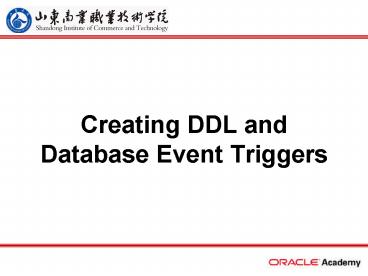Creating DDL and Database Event Triggers - PowerPoint PPT Presentation
1 / 19
Title:
Creating DDL and Database Event Triggers
Description:
Creating DDL and Database Event Triggers What Will I Learn? Describe events that cause DDL and database event triggers to fire Create a trigger for a DDL statement ... – PowerPoint PPT presentation
Number of Views:355
Avg rating:3.0/5.0
Title: Creating DDL and Database Event Triggers
1
Creating DDL and Database Event Triggers
2
What Will I Learn?
- Describe events that cause DDL and database event
triggers to fire - Create a trigger for a DDL statement
- Create a trigger for a database event
- Describe the functionality of the CALL statement
- Describe the cause of a mutating table
3
Why Learn It?
- What if you accidentally drop an important table?
If you have a backup copy of the table data, you
can certainly retrieve the lost data. But it may
be important to know exactly when the table was
dropped. - For security reasons, a Database Administrator
may want to keep an automatic record of who has
logged into a database, and when. - These are two examples of the uses of DDL and
Database Event triggers.
4
What are DDL and Database Event Triggers?
- DDL Triggers are fired by DDL statements CREATE,
ALTER or DROP. - Database Event triggers are fired by non-SQL
events in the database, for example - A user connects to, or disconnects from, the
database - The DBA starts up, or shuts down, the database
- A specific exception is raised in a user session.
5
Creating Triggers on DDL Statements
- Syntax
- ON DATABASE will fire the trigger for DDL on all
schemas in the database - ON SCHEMA will fire the trigger only for DDL on
objects in your own schema
6
Example of a DDL Trigger
- We want to write a log record every time a new
database object is created in our schema - The trigger will fire whenever any (type of)
object is created. We cannot create a DDL trigger
which refers to a specific database object. - But we can use ora_dict_obj_name event attribute
to know the affected object name
7
Example of a DDL Trigger
- CREATE TABLE log_table(
- user_name VARCHAR2(100),
- event_date DATE,
- detail VARCHAR2(400))
- CREATE OR REPLACE TRIGGER log_create_trigg
- AFTER CREATE ON SCHEMA
- BEGIN
- INSERT INTO log_table
- (user_name, event_date, detail)
- VALUES
- (USER, SYSDATE, 'Changed object is '
ora_dict_obj_name) - END
8
A Second Example of a DDL Trigger
- We want to prevent any objects being dropped from
our schema. - The trigger will fire whenever any (type of)
object is dropped. Again, we cannot create a DDL
trigger which refers to a specific database
object.
9
Creating Triggers on Database Events
- Syntax
- ON DATABASE will fire the trigger for events on
all sessions in the database - ON SCHEMA will fire the trigger only for your own
sessions.
10
Example 1 LOGON and LOGOFF Triggers
We can only use after with logon and before with
logoff, why?
11
Example 1 LOGON and LOGOFF Triggers
- We can trace users worksites by remembering
their IP address - CREATE OR REPLACE TRIGGER logon_trig
- AFTER LOGON ON SCHEMA
- BEGIN
- INSERT INTO log_table
- (user_name, event_date, detail)
- VALUES
- (USER, SYSDATE, 'Logging on from '
ora_client_ip_address) - END
- Here we used a event attribute called
ora_client_ip_address
12
Example 2 A SERVERERROR Trigger
- We want to keep a log of any ORA-00942 errors
which occur in our sessions
13
CALL Statements in a Trigger
- There is no END statement, and no semicolon at
the end of the CALL statement.
14
Mutating Tables and Row Triggers
- A mutating table is a table which is currently
being modified by a DML statement. - A row trigger cannot SELECT from a mutating
table, because it would see an inconsistent set
of data (the data in the table would be changing
while the trigger was trying to read it). - However, a row trigger can SELECT from a
different table if needed. - This restriction does not apply to DML statement
triggers, only to DML row triggers.
15
Mutating Table Example
16
Mutating Table Example
- UPDATE employees SET salary 3400 WHERE
last_name 'Davies'
17
Terminology
- Key terms used in this lesson include
- DDL Trigger
- Database Event Trigger
- CALL statement
- Mutating Table
18
Summary
- In this lesson, you learned to
- Describe events that cause DDL and database event
triggers to fire - Create a trigger for a DDL statement
- Create a trigger for a database event
- Describe the functionality of the CALL statement
- Describe the cause of a mutating table
19
Try It / Solve It
- The exercises in this lesson cover the following
topics - Describing events that cause DDL and database
event triggers to fire - Creating a trigger for a DDL statement
- Creating a trigger for a database event
- Describing the functionality of the CALL
statement - Describing the cause of a mutating table































